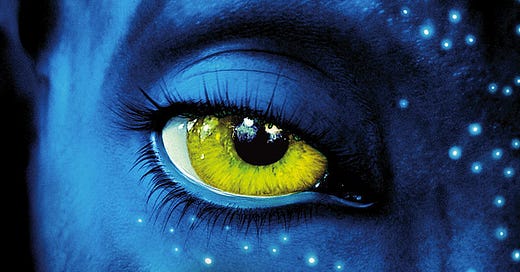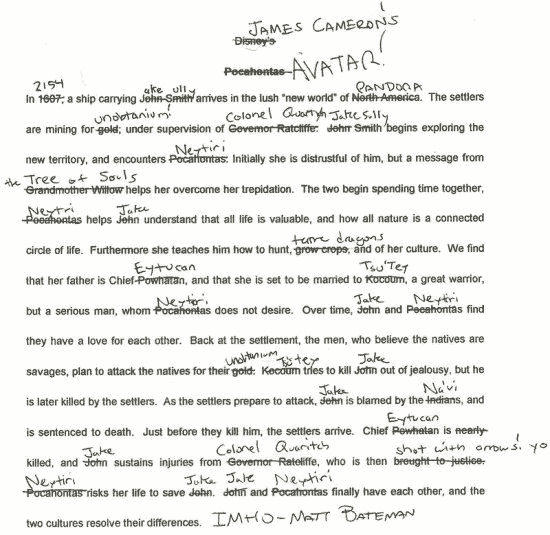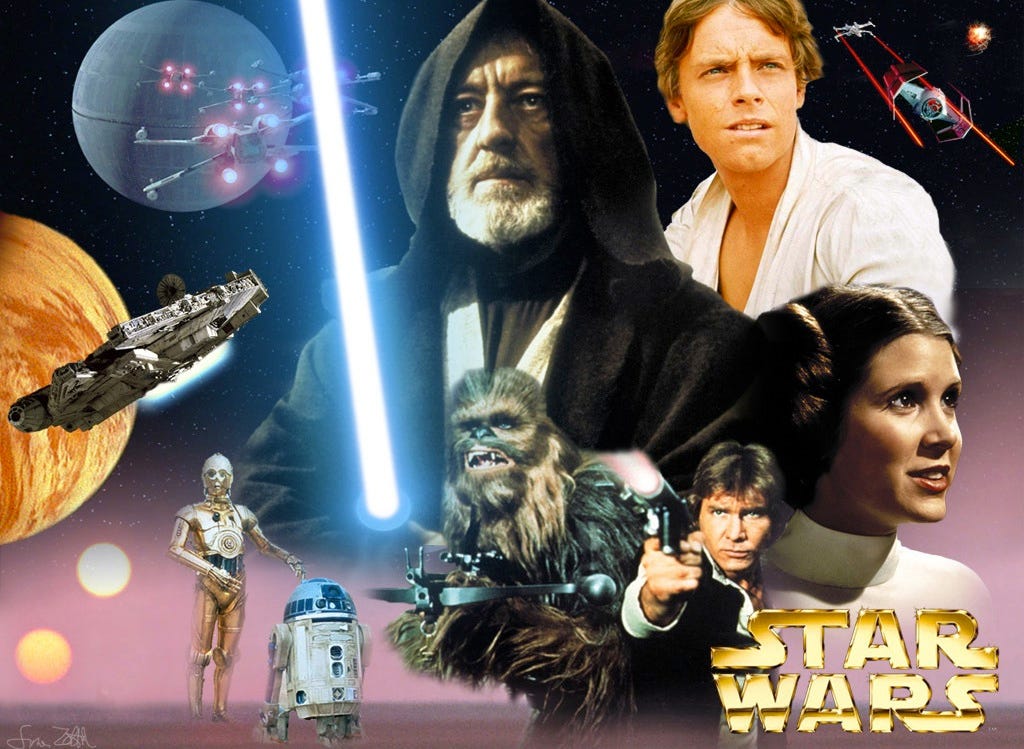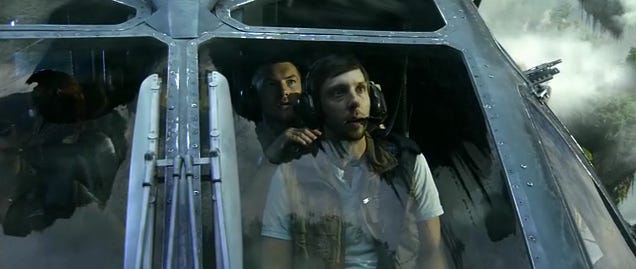Haiku Review: 'Avatar'
Miraculously non-problematic thoughts from way back in 2010
Lifting Fog continues its (belated) Academy Awards countdown roundup today with a review of another Best Picture nominee (...loser): HMFIC James Cameron's 'Avatar.' "We see you," jerks!
Story? ...Just enough.
But who cares! Special effects
Will make you shit bricks and
So is it Star Wars For a new generation? I mean kind of, but...
Say what you will about G.I. Joe: The Rise of Cobra, but 2009 was a pretty great year for movies. And across the board, too: boundary-pushing sci-fi in District 9; the (hilarious!) revisionist history of Quentin Tarantino's Inglourious Basterds. The Hurt Locker, Precious, Watchmen, Up. (500) DAYS OF SUMMER?!? Really just one of the more thoroughly satisfying -- and amazingly diverse -- array of films assembled in recent memory. We're spoiled. But one movie unquestionably stands out even in that accomplished crowd, a movie that pushed the technological edge of filmmaking farther than it's ever gone and silenced critics (...including me) who had written it off as "that Ferngully sequel" months before its release. The movie in question, of course, is Avatar, directed by a guy so ego-maniacal even his baseball cap seems to YELL at you. And while the story isn't much, there's no denying one thing: it sure looks great in blue.
Any discussion of the movie has to start with its visual and technological achievements. So let's start: this thing looks AWESOME. Before Avatar, motion-capture work probably saw its pinnacle in The Lord of the Rings (Gollum) and Pirates of the Caribbean (Davy Jones), sophisticated technology bringing a crackhead and squid-man, respectively, to vivid life. Cameron ups the ante tenfold here, with EVERY CHARACTER and (almost) EVERY BACKGROUND digitally composed -- an entire world created with computers and airplane hangars. It's been tried before, sure (think "Final Fantasy: The Spirits Within" and "creepily") but never with as much ambition or success. With its photo-realistic giant cat people and floating hippie mountains, Pandora is sort of in a league of its own.
Then there's the 3D, new technology of which James Cameron helped develop specifically for Avatar. New cameras were actually INVENTED to make this thing come together. (Did you do that, Blind Side?) And this isn't the retroactive 3D of pretenders-to-the-throne like Up or Clash of the Titans (or even Alice in Wonderland, which like Avatar was filmed with special cameras) -- the experience here is immersive in a way that goes beyond a couple of dynamic images. Cameron has said "this is a movie about voyage not just to another planet, but to another state of perception." And that's not inaccurate. Super egotistical, sure, but hardly indefensible; this movie is next-level spectacle, completely different from anything you've seen before.
So we arrive at the main question: Is this a benchmark film, like Star Wars? Does Avatar change everything?
I mean yes and no. The movie's immense popularity has clearly blown the door wide open on 3D; there are something like six 3D movies arriving this summer (Eat Pray Love is supposed to be MIND-BLOWING), and every major tentpole just starting production is following suit. For studio heads looking to boost profits through gouged ticket prices, Avatar's success is -- to quote one Mr. Joseph Biden -- a "big f*ckin' deal." Forget DVDs -- the "event movie" is back, and the only way to, you know, truly experience it is with a $16.50 IMAX 3D ticket and family size popcorn. Extra butter, please!
Of course on the "Avatar doesn't change anything" side of the coin, there's this:
What keeps our little movie that could from being a true game-changer in the vein of Star Wars or King Kong or The Wizard of Oz is the story. It's good, sure -- definitely not of the supreme low quality early trailers might have suggested -- but anyone watching Avatar with even a passing knowledge of recent cinematic history will recognize what a Frankenstein monster this thing is. Pocahontas. Ferngully. The Last of the Mohicans. The swing-for-the-fences mentality that obviously went into the visuals didn't translate to scriptwriting, where the guiding principle seems to be "just make it good enough."
I know there are people for whom Star Wars (and the original Star Wars trilogy) just as easily fits that description. It's a mish-mash of Joseph Campbell and Flash Gordon serials (with some Kurosawa thrown in for spice) that many consider emotionally stiff and -- along with Jaws -- almost totally responsible for the half-assed blockbuster industry we have today. But the latter claim is no more fair than blaming Pulp Fiction for Crash, or The Graduate (an overrated movie, but I digress) for Garden State. And the former is just ridiculous, because Star Wars is AWESOME. Immediately two reasons jump out:
1. Han Solo is a f*cking pimp.
For all his difficulties writing compelling dialogue, George Lucas created some truly unforgettable characters. And not just everyone's favorite slimy, double-crossing, no-good swindler, but Chewbacca. Darth Vader. Yoda. BOBA FETT. Their costumes are cool, sure (what 10-year-old boy or 40-year-old-man living in his mother's basement hasn't wanted to dress up like Boba Fett?), but it's their humanity -- or lack thereof -- that really captures our imagination. Take this scene from The Empire Strikes Back: Betrayed by his friend Lando Calrissian, Han Solo prepares to be frozen in carbonite and shipped to Jabba the Hutt. "I love you," Princess Leia finally admits. "I know." Thirty years later, these characters are etched into our cultural consciousness as strongly as Jay Gatsby or Jack the Ripper -- an indelible part of our world, fictional or not.
2. Cloud City doesn't want your tourist dollars.
One of the best things about Star Wars is the way it presents its galaxy not as something to "ooh" and "ahh" over, but as a lived-in collection of worlds brimming with dirty aliens and rusty spaceships. The Empire may have shiny uniforms for its foot soldiers, but outside those Death Star walls there is literally nothing new under the (twin) sun(s) -- the galaxy is really sort of a piece of shit. Hoth? With the Tauntaun stomach hotels? Tatooine, where you're as likely to be sold into slavery as to get your arm sliced off in a barroom brawl? I'd rather vacation in Kyrgyzstan.
Spectacle takes a backseat to story and character in Star Wars, propelling both when need be but never the point of any scene or shot. The awesomeness of Star Wars, really, lies in how nonchalant it is about its own awesomeness; it never tries to be cool...but simply is.
(Well, I think it is.)
30 years (and 500 words -- sorry!) later we finally get to Avatar, which rakes in a billion+ dollars at the box office and now eclipses Titanic, ANOTHER James Cameron production, as the highest-grossing film of all time. Buried in endless layers of hype and financial analysis and "big picture" essay writing, we realize there's almost no way to look at Avatar in strictly artistic terms -- it would be sort of pointless.
Acting? Just as in Star Wars, it's...fine. Sam Worthington isn't given much to work with in the character of Jake Sully, but that's kind of the point -- he's a cipher for the audience, guiding us through Pandora and learning as we do about the N'avi. Sigourney Weaver's chain-smoking scientist never saw a "Truth" commercial she didn't laugh at, and provides the requisite gravitas any big movie needs to really take off. Even the guy who played Katy Perry's boyfriend in the "Waking Up in Vegas" video does alright pulling double duty as a nerd researcher and nerd N'avi. The watchword throughout is good enough.
Zoe Saldana does deserve special mention for her work as Neytiri, a N'avi warrior/chieftain's daughter/whatever who falls in love with the blue version of Jake Sully and serves, ironically, as the most human character in the movie. Totally committed to the role (it is a full-retard performance for the ages), she breathes real life into the computer programming we see on screen. Sometimes too much, if the number of sexy Neytiri glances are any indication:
"Doctor, I'm worried about the way it suddenly doesn't feel that wrong to want to...you know...with a giant blue alien cat. Is that normal?" "Well, did you see this Avatar movie in 3D?" Yes." "IMAX, too?" "Yeah, the whole deal." "...I don't see any problem, then. I mean, I'd hit that." Avatar does for inter-species canoodling what Harold and Maude did for old people fetishes. It's all good!
But more than the lack of interesting characters (Neytiri aside), what really renders the movie something less than an all-encompassing cinematic event is how overtly James Cameron tries to make this an all-encompassing cinematic event. We're never allowed to take Pandora in on our own terms the way we did Hoth or Tatooine in Star Wars; instead our hands are held TOO TIGHT as the camera screams "here!" and "here!" Every moment in Avatar calls attention to itself, almost demands that you acknowledge the awesomeness unfolding in front of you. Spectacle is the point. But what's the ultimate fun in being told, however implicitly, how to enjoy something? How interesting is a two and a half hour advertisement from the Pandora Board of Travel and Tourism?
Avatar is an incredible motion picture achievement. For years to come, any work in the realms of motion-capture, 3D production, or general special effects will use this as a touchstone. That's indisputable. But for all the little kids growing up with this as the biggest movie they've ever seen, all the writers and commentators who had to eat crow (again) and acknowledge the HMFIC's unmitigated movie-making prowess, and all the seriously disturbed "Avatards" out there longing to leave their earth-bodies behind and live on Pandora...it's still nowhere near Star Wars*.
And it never will be.
* TO THOSE CHILDREN WHO MIGHT BE READING THIS BLOG (Why are you reading this blog? Shouldn't you be in bed?): Any mention of "Star Wars" or the "Star Wars Trilogy" are not in reference to the toy-filled nightmares of Episodes I, II, and III, but those classic movies that left an indelible mark on the human (well, NERD) imagination starting in 1977 and continue -- even in spite of Jar Jar Binks -- to inspire and captivate audiences worldwide. Look it all up on Wikipedia.









